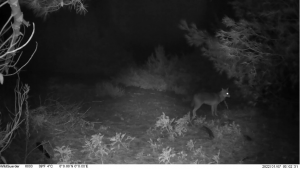Golden Jackal first sighting in Maremma confirmed through TEF MAPAT grant!

The golden jackal Canis aureus is a canid of conservation interest included in Annex V of the Habitat Directive 92/43 EEC. This species arrived in Italy spontaneously in the 1980s thanks to the dispersive push of some individuals from the Balkan area (Lapini et al., 1993).
The first reports and the first reproductive nuclei were in fact documented in the north-eastern part of the peninsula, where the first ascertained data dates back to 1984 (Lapini et al., 1993). Subsequently, the jackal spread to most of the regions north of the Po River (Lapini et al., 2018), which probably slowed down the dispersal of this canid towards the south. Only recently, in fact, the species has been reported south of the Po in Emilia-Romagna (Lapini et al., 2021), in Lazio (Circeo National Park, in 2020-2021: Fortebraccio & Aleotti, 2022) and in Tuscany.
In this latter region, a first report relates to the province of Prato and dates back to the end of 2021 (Bacci & Lunghi, 2022); in March 2022 another individual was found invested near Empoli (E. Mori & A. Viviano com. pers.). Therefore, the report reported here for the Maremma Regional Park represents the southernmost location in the Tuscany Region.
The University of Siena and the Maremma Regional Park Authority have been conducting a research project on the ecological relationships between the species that make up the local mammal community for several years, integrating a series of techniques including video trapping (Ferretti et al. , 2021; Rossa et al., 2021).
This is done using a sampling grid of 1km2 x 1km2 and 60 monitoring stations kept active throughout the year. Each workstation is visited approximately once a month to replace the SD cards and batteries; over the following weeks the videos are viewed and the related data is archived. During the check of the videos recorded during the winter season, the presence of 2 night videos was detected which portrayed a golden jackal (Fig.1), recorded in the same location on 7 January 2022 (at 3:02 and 17:47 ).
Considering the exceptionality of the observation, as well as the potential difficulties in identifying the species, subsequent further checks were carried out on the films taken in the same period in the other surveying locations. Three other camera traps were also positioned near the location where the dog was reported. However, no further documentation of the presence of the species in the Park has been obtained.
The videos were shared with Dr. Luca Lapini (Friulan Museum of Natural History, Udine), editor of the Canis aureus NEWS bulletin, for a comparison and shared validation of the report. Considering the high intensity and continuity of sampling in progress, it is conceivable that the report cannot be referred to a stable presence, although further answers may naturally come from continuing to collect data on a standardized basis.
The stable presence of the wolf has been found in the area for years (Ferretti et al., 2019, 2021; Rossa et al., 2021): this predator is a possible significant competitor for the golden jackal, potentially able to influence its abundance and distribution , and could therefore slow down any stable establishment of the jackal in the area (Krofel et al., 2017; Mohammadi et al., 2017; Lapini et al., 2021). The continuation of the ongoing research will in any case make it possible to evaluate the evolution of the actual presence of the golden jackal over time, as well as the potential ecological relationships with the other carnivores present in the area (e.g., Ferretti et al., 2021; Rossa et al., 2021).
